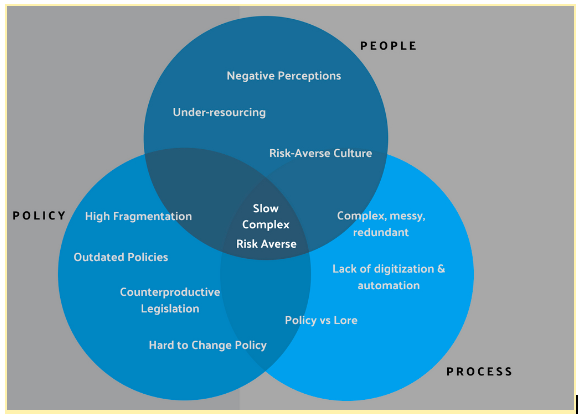
 This guest blog is by Mariam Pallathucheril is a summer research fellow at CoProcure and a current MPA/MPP candidate at Columbia University (SIPA) and the Hertie School of Governance concentrating in Economic Policy and Technology.
This guest blog is by Mariam Pallathucheril is a summer research fellow at CoProcure and a current MPA/MPP candidate at Columbia University (SIPA) and the Hertie School of Governance concentrating in Economic Policy and Technology.
She received her Bachelor’s degree in Economics and Government from Georgetown University.
We’ve all heard “public procurement is broken.” But how is it broken, and why? We spoke to more than 200 local government staff and vendors to find out. In this series, we share what we learned and what it means for working together to improve public procurement.
Public procurement is at the heart of nearly everything governments do. Approximately 1 of every 3 dollars governments spend go towards purchasing something, from fire trucks and road salt to software. This spending isn’t chump change; total U.S. federal spending is nearly 4 trillion dollars each year.
But this huge (and hugely important) function elicits passionate negative reactions. Bring up procurement with someone who works in the public sector or someone trying to sell into government, and brace yourself for some strongly-worded kvetching, a handful of traumatic stories, and possible heavy sighing. In the words of one startup vendor we spoke with: “procurement is death.”
As a public policy student at Columbia’s School of International and Public Affairs (SIPA), I’d heard that “public procurement is broken.” But I had to wonder: when people say this, what exactly are they talking about? Exactly how is procurement broken?
As a summer research fellow at CoProcure, I’ve been part of a team attempting to diagnose what makes public procurement so painful. Over nearly 8 months, CoProcure conducted more than 200 interviews with individuals that engage the local public procurement process: from procurement officers, contract administrators, and innovation teams to Chief Information Officers and Economic Development Directors; City Managers; Councils of Governments; and vendors of all sizes. We then set about to group what we heard into categories and create a taxonomy of problems.
Overall, three categories of problems emerged, which we call the three Ps: policy, people, and process.
Policy problems are the category of problems created by procurement rules and regulations. These regulations are highly fragmented, which makes them hard to navigate for government staff and vendors, especially those with less experience. Regulations are oftentimes in desperate need of updates, since many of them, while well-intended, work against a government’s objectives. However, policy is tough to change.
Stakeholders noted that the incentives for elected leadership to change policy are weak and, since policy reform can quickly become politically-charged, local bureaucrats tend to avoid taking on regulatory reform. Some cities that want to make policy changes and have the political will lack the internal capacity to make significant updates.
People problems are caused by the individual stakeholders in procurement, how procurement is organized, and the cultural environment in which stakeholders make decisions. Government stakeholders operate in a risk-averse environment; when it comes to purchasing, risk-aversion creates a bias for sticking to established processes and working with experienced, larger vendors, even if those steps result in poor outcomes.
We also found that negative perceptions of the role of purchasing undermine trust between purchasing staff and their colleagues from other departments. Government stakeholders also feel under resourced and ill-equipped to handle the volume of purchases and new types of purchases, especially in the technology category.
Process problems are where policy and people come together. Process is about the decisions that government staff make based on policy and what has been “done before” in the organization. These decisions typically involve multiple, messy, redundant steps that are time-consuming and frustrating to government staff and vendors alike.
Taken together, policy, people, and process factors contribute to making procurement incredibly complex to navigate, slow-moving, and risk averse. Navigating locally-specific policy and process complexities; accommodating the pace of procurement; and attempting to innovate in a culture of risk-aversion were common pain points shared by government staff and vendors alike.
You may have noticed that the three Ps are government-specific. We heard many pain points from the vendor community, too. Vendors, especially smaller vendors, struggle to find appropriate opportunities and government champions; cite time-consuming processes and long sales cycles as extremely costly; and encounter obstacles, like capital and bonding requirements, that can be unexpected hurdles.
While we acknowledge these pain points, and hope to work with governments and vendors to address them, we believe that their root causes largely stem from government factors. We believe addressing these challenges on the government side will alleviate pain not just for government staff, but for vendors as well.
In the next several posts, we’ll flesh out the three Ps in greater detail. We’ll also highlight some of the innovative solutions that governments across the United States are testing out to alleviate the pain in these categories and improve procurement for government staff and businesses.
We are sharing this research because the challenges ahead are large.
Our interviewees often expressed feelings of helplessness and cynicism; many were skeptical that procurement’s fundamental challenges are solvable. But we also felt inspired by those we spoke with who, in spite of the scale of procurement challenges, are finding ways to make improvements.
We’re excited to add momentum to a growing group of individuals and organizations passionate about making progress on public procurement. We hope these insights can be helpful to this broader effort.
CoProcure makes it easier for local governments to find, buy, and share high-quality technology products from a more diverse set of vendors via streamlined, cooperative purchasing.
With CoProcure, governments save time and money, access new technologies faster, and engage new types of businesses. Want to learn more? Say hi: hello@coprocure.us.
